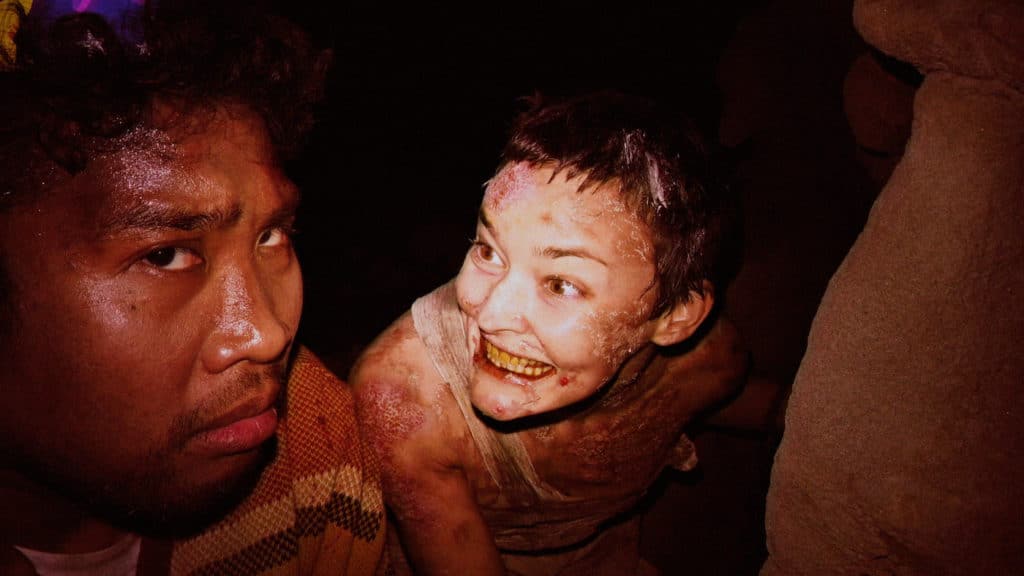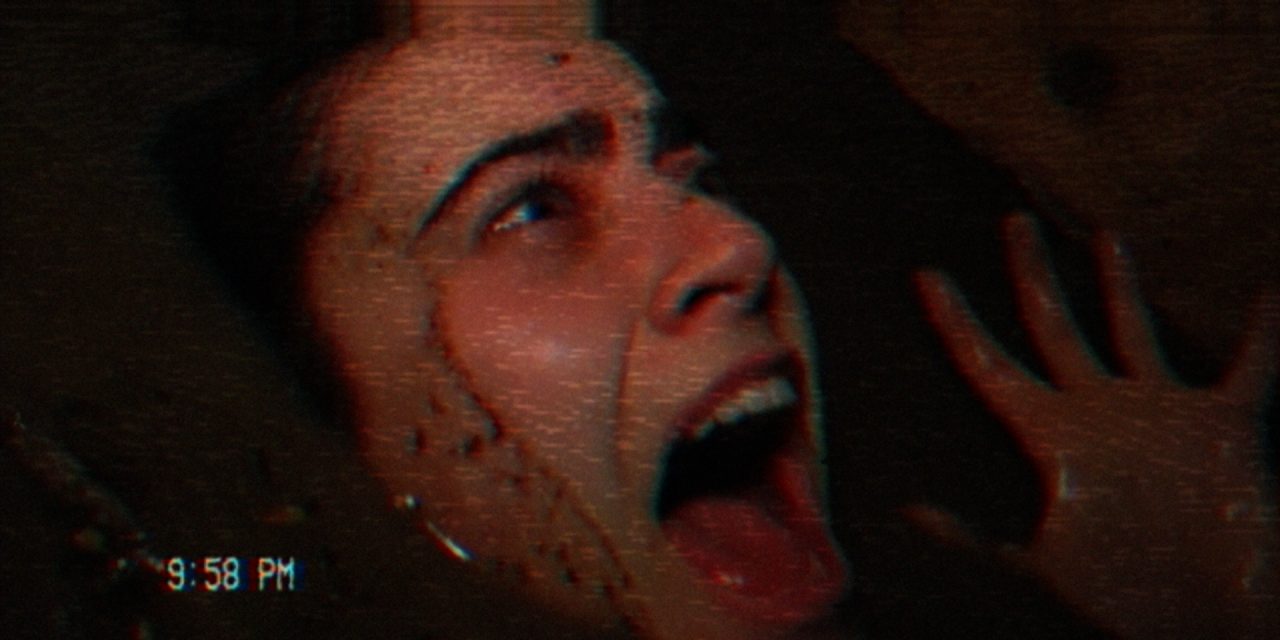
Even those people for whom nostalgia seems to be a kind of tragic full-time job would likely struggle with V/H/S/99 (2022). Okay it’s better than V/H/S/94, but surely that’s damning with faint praise. It clings onto the same silly tics in any case, with the same religious devotion to all those shitty elements of analogue technology which were annoying the first time around. Second, third, fifth, seventh time around, seeing ‘TRACKING’ or watching a frame dissolve into snow as part of the chosen framing device of a brand-new film – well, you can only admire the singlemindedness. Use it to pad out five individual films of wildly varying quality, come what may, and that is some fighting spirit.
The annoying thing here (or one of the annoying things) is that one of the segments turns out to be rather good; one more is passable; the rest are dreadful. But they alternate, so although we get some much-needed variety and quality in the mix, the overarching film feels uneven: it goes bad-good-bad-okay-indifferent. It’s a big fat curate’s egg, essentially, and it takes nearly two hours to chow through. Then the individual films – despite having different directors, as usual – all share plot similarities, as they’re almost all about: pranks, teenage peer pressure, being the butt of the joke and finally, the supernatural, which rides in at the end like the cavalry. And although the dreaded wraparound feature looks to have been left out, we still get a silly conceit about a game of toy soldiers (evidently made to look as though a kid has made an animated film of his own) which feels like a wraparound, as it pops up – as if it’s been taped over, natch – again and again. Light relief? Or padding? Let’s go with padding. It felt like padding. A film which is one hour, fifty minutes long does not need padding.
The first segment, Shredding, is another group of young ‘uns trying to make their own film, which largely consists of pranking one of their number in particular as they enjoy the usual pastimes of skateboarding, being in a band, Hot Topic goth fashion and bursting in on one another on the toilet. When not doing that they share a tale of an urban legend, about a band called Bitch Cat (or Kat – should really be Kat) who died, alongside a number of their fans, in a club fire. Cool, let’s go see! So they go see, and it’s everything you might expect. Because this film is so weak and it’s the first one people will see, it operates as a kind of litmus test: it’d be interesting to know who turns the film off at this point. That’s an issue with this framework: as a Shudder original anthology, it seems to trust that the constant jibber-jabber and people talking over one another won’t be minded at all by its audience, who may well be doing the same. But you still need some surprises or some big scenes, and there aren’t any here, aside from the enthusiasm with which people setting films way back in time seem to relish the opportunity to throw in language which wouldn’t fly in 2022. There’s more like that in other segments, too.
The next film, thankfully, is mean-spirited and SFX-laden enough to distinguish itself from all of the other segments here, and it’s nice that the director in question is Johannes Roberts, who clearly understands how to fit a lot of horror into a short amount of time without the endless dialogue. Suicide Bid satirises the bizarre American tradition of putting those hoping to join a fraternity/sorority through hazing rituals; people have genuinely died as a result of these, and they have a reputation for being anything from spectacularly stupid to incredibly dangerous. Pulling this existing phenomenon into a horrific fantasy universe, we have the story of Lily (Ally Ioannides), who’s is told by her would-be sisters that she has to spend the night in a coffin: she can ask for help, but if she does, she can’t join, so the pressure’s on to go the distance. Oh, and just before time, the girls tell her all about a local urban legend about a girl who tried it and didn’t make it… It looks like there are a few nods to Fulci here – spiders, in-coffin camera shots – but even if this is a mere coincidence, then it certainly prevents a lot of the static shots in the film becoming turgid, and kudos for the very good SFX work which brings things to a decent conclusion.
Segment three is Ozzy’s Dungeon, and it looks like something between The Running Man and Pat Sharp’s Funhouse – being a cable TV gameshow where kids compete in increasingly grisly and ill-advised games to have their ‘dreams come true’. When a game goes badly wrong, a disgruntled parent decides to get their own back on the host. There’s some potential subtext here in the form of Ozzy’s blatant exploitation of his participants, but most of that gets parked so that the film can focus on what seems a lot like proto-ordeal horror, then not much more than a glint in James Wan’s eye of course. It’s all so shouty, though, and suffers a lot by essentially repeating the cable show sequence twice, before segueing into a plot twist which felt like a bridge too far – shifting the tension away from the initial key players, fine, but diluting the sense of involvement and interest in the initial story arc.
The Gawkers is interesting in the way it splices two key things together: permission for a group of deadbeat boys to spy on their ‘hot piece of ass’ neighbour – because ‘it’s 1999’ – with what feels like a completely obvious about-face where they get their comeuppance – because it’s 2022. The cast all fall asleep at one point, which isn’t a good sign in a short film, even if director Tyler MacIntyre does this in a knowing way. But there’s some modest fun to be had with this, if you suspend your critical eye for the effects used – effects even a VHS palimpsest can’t quite obscure.
Finally, there was hope when it turned out that Joseph and Vanessa Winter directed To Hell and Back, as their film Deadstream is an updated, improved descendant of this kind of found-footage style, which shows how far we’ve come, in real time. It starts off on the eve of Y2K, with a group of people preparing for an occult ritual in suburbia; fair enough, it was expensive to get tickets for things. It starts with a reasonably light touch and some humour, though it moves the action elsewhere (you may guess where) in what looks like another nod to Fulci; the problem is that the humour and characterisation begin to feel rather opaque against this rather samey, but all-encompassing background. That all being said, you wouldn’t envy any film being placed at the end of this anthology. By this point, after five with significant thematic overlap, minutes devoted to a frame which contributes nothing much, and irritating inclusions around the films themselves, the conceit has worn very thin.
Everything about the Y2K setting feels overdone, but equally, a waste: only one film even touches upon what was an interesting point in history, with real anxieties about the possibilities of missiles falling out of the sky. With the exception of a nod and a wink from the Winters – although little else substantive – the 1999 thing is only used as a last-chance opportunity to use the VHS framework before DVD comes in properly and wrecks the game. Beyond that, we get some gleeful word choices ‘from back then’ and some black lipstick (and, by the by, if you’re going to fixate on getting the jewellery and make-up right, remember that girls at the time plucked their eyebrows into incredibly tiny arches; all of the massive 2020s eyebrows can only give the game away. It’s a minor point, but it’s still noticeable). Of course, you can make the argument that the VHS thing is all meant to be part of the charm. You could even say it’s the point; it does feel like that in places. Fine. But if you take these stories for what they are, trying to forget the VHS frippery draped everywhere, then they are for the most part dilute and unremarkable. A few high points aside, V/H/S/99 is a hot mess, and it should be the last of its line.
V/H/S/99 (2021) will be released on Shudder on Thursday, October 20th 2022.
